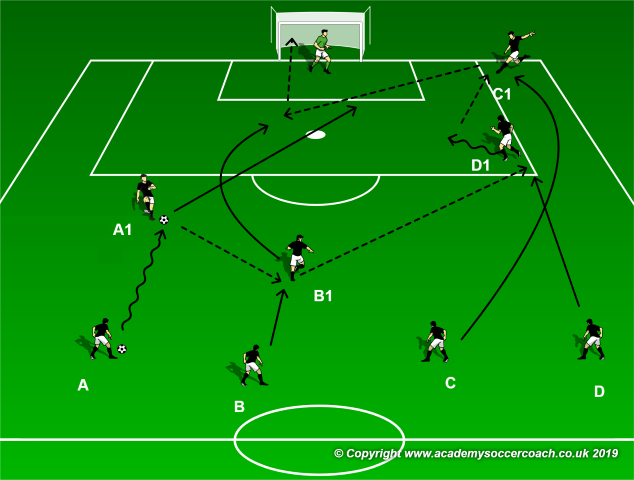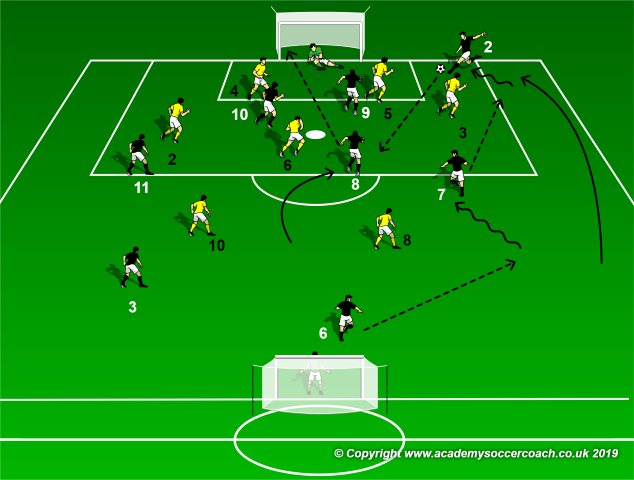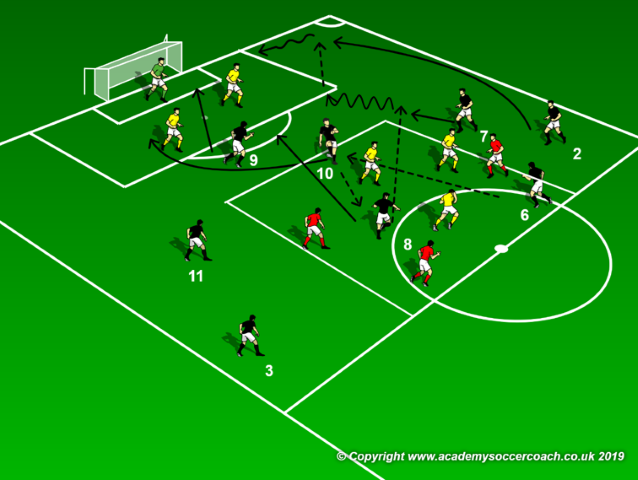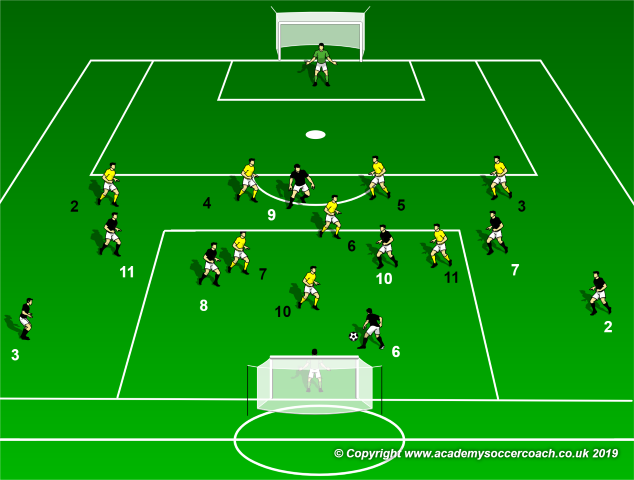By Philip Cauchi
The following training session aims to develop the communication links between the central midfielders, lateral midfielder, full back and striker during the creative phase of the build-up and the finalization phase. We derive this from our point of reference which is our style of play and the principles and sub-principles that form it. It is therefore important for the players to experience situations in training that help them to develop habits. From these habits, communication and decision-making can be developed. Players will be able to understand better the movements of their teammates and what actions the situation requires to perform to be of service to their team.
Session No: 3 of 4.
Session title: Developing communication between the lateral chain and central midfield unit and striker.
Total duration: 86 to 90 minutes.
Moment of play: Team in possession.
Team task: Attack build-up.
System of play: 1-4-2-3-1.
Theme: Attack build-up on the flanks.
Aim: Play in verticality using the flank players to create width and depth in search of penetration.
Outcomes:
1. Width in attack provided by either the full backs or lateral midfielders.
2. Depth or length created by the striker.
3. Off-the-ball movement and combinations between the flank players.
4. Staggered angles in midfield between the 6, 8 and 10.
5. Attack first and second posts.
6. Support runs from deep.
7. Support on the edge of the penalty area,
8. Preventive marking to counter press if possession is lost.
N.B. As a coach you might want to emphasize on only three or four outcomes. The list of eight outcomes is just a guidance of what we might want to focus on in the session.
Warm-up: Activation and wing play practice.
Targeted outcomes: 1, 2, 3 and 5.
Duration: 25 minutes.
Players: Groups of four.
Area: 25 yards by 15 yards.
Description: Prior to this exercise the players perform movement preparation exercises that involve skipping and running coordination. These exercise should be interspersed with dynamic stretching and mobility. Dynamic core stability exercises should also be included towards the end of this phase. To activate the neuro-muscular system, agility ladder exercises will be used. This part should take approximately fifteen minutes.

In above illustrated exercise we work on performing basic movements when attacking from the flank. This activity simulates switching play and then an overlap occurs on the flank zone with the aim of creating space and further options to play. The activity therefore starts with player A dribbling forward, then passes diagonally backwards to player B who creates an angle to receive with an open body prior to playing a long pass to switch play towards player D. As player D is about to receive the ball, player C overlaps him. Player D cuts inside with the ball and passes to player C to deliver the cross. Players A and B cross-over to attack the first and second posts respectively. The exercise should be repeated from both the right and left sides of the pitch.
Global activity: Game – Playing in numerical superiority.
Targeted outcomes: All.
Duration: 18 minutes – 2 x 8 minutes interspersed with two minutes of rest.
Players: Team coached plays in a 1-4-3-1 system of play (advanced full backs) against the opposing team who plays in a 1-4-3 formation.
Area: 55 yards in length by 60 yards in width.
Description: We play a game where the coached team is given a numerical advantage – 8v7. The scope is for the team to utilise the flank by outnumbering the opposition’s full back. In the illustration below it is players 2 and 7 of the attacking team against the defending team’s full back 3. The opposing team are instructed to play with three central midfielders. The attacking team (blacks) are left to figure out a way to penetrate on their own.

Make the players think of where the opportunities to penetrate are. Ask them how these could be exploited. We can then play in numerical parity or even in inferiority to further stretch the players’ game insight and level of communication.
Analytical training situation 1: 3v3+3 in the centre to attack on the flanks and finish.
Targeted outcomes: All.
Duration: 10 minutes – rest included between attacks and restarts.
Players: Attacking team has three midfielders inside the rondo area, a striker and a full back and a lateral midfielder on each side. The defending team has three midfielders inside the rondo area and two central defenders. Three neutral players play with the team in possession and are situated inside the rondo area.
Area: 55 yards in length by 60 yards in width with an inner rondo area measuring 20 yards by 20 yards.
Description: Play is 3v3 inside the rondo area. After making five consecutive passes, the attacking team plays the ball to attack from either flank. Attacks should take place alternately from the left and right flanks and against the two central defenders. Coordinated movements between the lateral midfielder and full back is imperative.
In the below example, lateral midfielder 7 receives the ball and plays a vertical pass into the overlapping full back’s path. The striker (9) and the two midfielders (8 and 10) overload the penalty area against the two central defenders. The striker attacks the first post while midfielder 10 attacks the far post. Midfielder 8 moves towards the edge of the penalty area. Like the lateral midfielder 7, this player supports the attack for a cut back passing option. We could also instruct the opposite midfielder 11 to attack the second post and midfielder 10 to attack the mid-post. As a progression we could ask one of the defending midfielders to track back and defend.
A further progression would be to ask another of the defending midfielders to try and prevent the cross. This progression forces the lateral players to think and be creative with their movements, thus finding a way to play the ball into the penalty area. This can either be from a cross, a cut back pass, or simply the attacker on the ball opting to cut inside and take a shot on goal or combine with the other attackers.

Analytical training situation 2: Attack down the flank.
Targeted outcomes: All.
Duration: 10 minutes – rest included between attacks and restarts.
Players: Team to be coached plays in a 1-4-3-1 system of play (advanced full backs) against the opposing team who plays in a 1-4-4 diamond formation.
Area: 55 yards in length by 60 yards in width with an inner rondo area measuring 20 yards by 20 yards.
Description: Inside the rondo area we have our three midfielders against the four midfielders of the opposing team. This simulates playing against a team with a midfield diamond. After completing five sequential passes, the attacking team must play the ball out of the area and to either attacker 2 (full back) or 7 (lateral midfielder). From here the attacking team (blacks) attacks against the opposition’s back four. Progress this to attacking against a back four and a midfielder who tracks back and defend.

Global game: 8v8 plus goalkeepers.
Targeted outcomes: All.
Duration: 18 minutes – 2 x 8 minutes interspersed with two minutes of rest.
Players: Attacking team (blacks) plays in a 1-4-3-1 system of play (advanced full backs) and the defending team plays in a 1-4-4 diamond formation.
Area: 55 yards in length by 60 yards in width.
Description: Normal match where the coach observes the behaviour of the team when the ball is on the flanks. The coach should change the formation of the opposing team to a flat 1-4-4. From here the coach will assess his players if they are capable to adapt to the change in the circumstances. Now the opponents have two players on both flanks. Ask the players how they aim to penetrate the opposing defence. Do they still try to penetrate from the flanks? Do they aim to stretch the opposition in search of creating space centrally?
Conclusion: Light passing in pairs.
Duration: 10 minutes.
Light passing exercises in pairs within a light dynamic environment where the players move to offer another angle after the pass. This is performed as a cool down. End the sessions with static stretching exercises with particular emphasis on the glutes, hamstrings, adductors and hip flexors.
By Philip Cauchi


